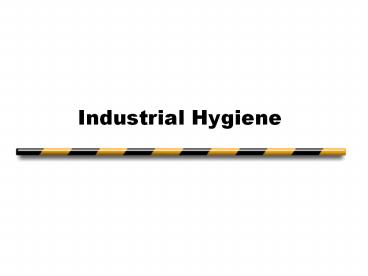Industrial Hygiene - PowerPoint PPT Presentation
Title:
Industrial Hygiene
Description:
Industrial Hygiene Industrial Hygiene A specialization in the broad field of safety and health. OSHAct and Industrial Hygiene Use Warning Labels Use proper PPE s ... – PowerPoint PPT presentation
Number of Views:302
Avg rating:3.0/5.0
Title: Industrial Hygiene
1
Industrial Hygiene
2
Industrial Hygiene
- A specialization in the broad field of safety and
health.
3
OSHAct and Industrial Hygiene
- Use Warning Labels
- Use proper PPEs
- Provision of medical tests
- Maintain accurate records
- Accessibility Availability of tests
monitoring to employees - Notification of employees who have been exposed
to environmental stressors
4
OSHA Process Safety
- Coverage
- Employee Participation
- Process Safety Information
- Process Hazard Analysis
- Standard Operating Procedures
- Requirements for Contractors
5
MSDS Sheets
- General Information
- Hazardous Ingredients
- Physical Chemical Characteristics
- Fire Explosive Hazard Data
- Health Hazards
- Safe Handling and Use
- Control Measures
6
Points of Entry
- Inhalation
- Absorption
- Ingestion
- Injection
7
Effects
- Acute
- Sudden dose, high concentrations
- Chronic
- Gradual dose over a period of time
8
Airborne Contaminants
- Dusts
- Fumes
- Smoke
- Aerosols
- Mists
- Gases
- Vapors
9
Effects of Airborne Contaminants
- Irritants
- Irritation to the skin, eyes, nose, mouth,
throat, and upper respiratory tract - Asphyxiants
- Disrupt breathing so severely that suffocation
results - Narcotics
10
Common Industrial Hygiene Problems
- Asbestos
- Sick Building Syndrome
- Explosive Hazards
- Confined Space
11
Exposure Thresholds
- Time Weighted Average (TWA)
- Short-term Exposure Limit
- Exposure Ceiling
12
Recognizing Hazards
- What is produced?
- What raw materials are used?
- What additional materials are used in the
process? - What equipment is used?
- What operational procedures are involved?
13
Recognizing Hazards
- What dust control procedures are involved?
- How are accidental spills cleaned up?
- How are waste by-products disposed?
- Is there adequate ventilation?
- Are the processes equipped with exhaust devices?
14
Recognizing Hazards
- How does the facility layout contribute to
employee exposure? - Are properly working PPEs available?
- Are safe operating procedures recorded, made
available, monitored and enforced?
15
Control
- Engineering Controls
- Ventilation
- PPEs
- Administrative Controls
- Additional Strategies
16
Important Laws
- OSHA Chemical Process Standard
- EPA Clean Air Act
- SARA
- Hazardous Materials Transportation Uniform
Safety Act.
17
Confined Space Standard
- Shutdown Equipment/Power
- Test Atmosphere
- Ventilate the Space
- Have Rescue Personnel Stand By
- Maintain Communication
- Use a Lifeline
18
Industrial SafetyIT 335
- Chapter 16
- Noise and Vibration Hazards
19
Characteristics
- Noise
- Unwanted sound
- Decibel
- Measurement of sound
- Threshold of Hearing
- Sounds heard by the human ear
- Threshold of pain
- Max level of sound without experiencing pain
20
Hearing Loss Factors
- Intensity of the Noise
- Type of Noise
- Daily Duration of Exposure
- Total Duration of Exposure
- Individuals age
- Coexisting hearing problems
- Nature of the Environment
- Distance from the source
- Position of the ears relative to the sound source
21
Critical Noise Risk Factors
- Noise Level
- Frequency
- Duration
- Distribution
22
OSHA Regulations
- Monitoring Noise Levels
- Medical Surveillance
- Noise Controls
- Personal Protection
- Education Training
23
Workers Comp. Hearing Loss
- Onset and Progress of the employees history of
hearing loss - The employees complete work history
- Results of a hearing exam
- Results of hearing studies
- Determination of whether the loss originated from
outside the workplace
24
Identifying Noise Hazards
- Noise Surveys
- Audiometric Testing
- Record Keeping
- Follow-Up
25
Noise Controls
- Engineering Controls (pg 378-379)
- Administrative Controls (pg 380)
- Hearing protection (pg 380)
26
PreventingVibration Hazards
- Low Vibration tools
- Limit Employee Exposure
- Change Employee Work Habits































